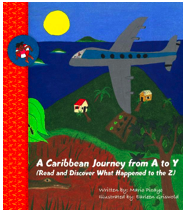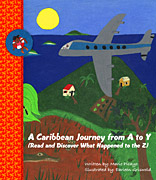Campanita Books is happy to announce that A Caribbean Journey from A to Y (Read and Discover What Happened to the Z) Sold over 10,000 copies in December, and was selected as a 2008 Americas Award Commended Title.
What’s so Special about this ABC? Read the following selected Reviews and Comments:
“This very original alphabet book gives brief descriptions of many aspects of the geography, animal species and history of the Caribbean. Even though a reader might consider an alphabet book as appropriate only for beginner readers, this one has so much information and poetic language, that older, more mature children will benefit from the information conveyed. Colorful and detailed naïve illustrations accompany the text. The best part of the book is finding out what the Z means to the Caribbean”. (gr K-4)
— 2008 Americas Award Commended Title
“A Caribbean Journey from A to Y, written by Mario Picayo and illustrated by Earleen Greiswold, describes insular portions of the Caribbean region in a manner that truly teaches and delights the child reader for whom the book is intended. Told as an account of the letters of the alphabet, the verbal side of the story engagingly caters to the child’s curiosity offering invaluable information about the flora, the fauna, the landscape, and the human populations of the region. Picayo delivers historical details throughout with beautiful simplicity, as in the explanation of “what happened to Z,” which alerts readers to the slavery period and the presence of Africans in the cultures of the region. With equal command of well chosen details, Griswold’s visual side of the story of Caribbean Journey from A to Y depicts the rural, the urban, the past, the present, tradition, and change without resorting to binaries, while giving women their due at the center of life in the Caribbean and suggesting the region’s racial and cultural diversity. The images and the words combine to disrupt many of the visual and discursive stereotypes that often recur in representations of the Caribbean. I can think of no better book for children to begin the life-long adventure of knowing the Caribbean”.
–Silvio Torres-Saillant. Author of An Intellectual History of the Caribbean
“Mr. Picayo, from his personal experiences, has compiled a fascinating collection of historical and natural facts.
All young people in our islands and elsewhere, would gain immense knowledge and enjoyment from the lively narrative and brilliant illustrations. A Caribbean Journey should be on everyone’s reading list.”
–Prof. Roy L. Schneider, M.D., Former Governor, United States Virgin Islands
“Mario Picayo’s A Caribbean Journey from A to Y is a book sure to motivate kids to read it over and over. The illustrations and the artistic appeal of the book make it really stand out among other children’s books.”
–Glenn “Kwabena” Davis, Director of the V.I. Education Dept’s Culture Division
“From a Caribbean perspective, this book is relevant to children living in the Caribbean and also to those children living outside the region. A Caribbean Journey is a must have in every library, and great learning tool in which a person of any age could pick up and learn a thing or two.”
–Myron Jackson, Executive Director of the Virgin Islands Cultural Heritage Institute
“ A simple search in the Internet will tell us that few ABC book about the Caribbean exists. Another, more complex search allows us to see that these kinds of texts usually are limited to the normal experiences of a traditional US or European child. A Caribbean Journey from A to Y (Read and Discover What Happened to the Z), published by Campanita Books is an alternative to bigger publishers that don’t yet know the market or tastes of Latino and West Indian families nor take them into account in their marketing. This book is a learning experience on many levels, in terms of text and illustrations. The simple name of an island is made into new and valuable information to add to children’s vocabulary when we discover that “St.” means saint and that there is a big island that an astronaut comes from. In the illustrations we see people of all colours and sizes, carrying out different activities that are particular to the Caribbean. These are today’s natives, past natives, tourists and dozens of starting points for lessons on history, science music and vocabulary. But a child isn’t given a book only because of the lessons we can get them to learn. A book is an object that activates the imagination and transports them to other worlds. For a nine year old child, like mine, a book has to provide just the right details to fire his desires and passion. It could be the birds or the iguanas, the flags, the volcanoes the indigenous people or the yachts. A Caribbean Journey from A to Y (Read and Discover What Happened to the Z) has all of these and more. It’s written to entertain and educate and to leave us with more questions to answer. At the end, the Z surprises us with an invitation to make a leap across the Atlantic and continue the journey”.
–- Tanya Torres is a Puerto Rican artist, cultural activist and writer who lives in New York. In 2002 she was selected as one of the 50 Women of the Year by El Diario/La Prensa, New York’s oldest and most read Spanish language newspaper.

A Caribbean Journey from A to Y (Read and Discover What Happened to the Z)
ISBN: 978‐0‐9725611‐8‐1 Format: Hardcover Price: $19.95 Number of pages: 64
Available at your favorite bookseller,
including Barnes & Noble and Amazon.com.




 This application for your iPhone comes with a lot of great features. You can go to any page very easily and save your progress in case you need to come back to your book later. The settings section allows you to change the font size and style, change the way the pages turn (to give it amore realistic feeling), and change the screen color (black/white or reverse). And just like with the iPhone you can change from portrait to landscape depending on what you like better.
This application for your iPhone comes with a lot of great features. You can go to any page very easily and save your progress in case you need to come back to your book later. The settings section allows you to change the font size and style, change the way the pages turn (to give it amore realistic feeling), and change the screen color (black/white or reverse). And just like with the iPhone you can change from portrait to landscape depending on what you like better.

